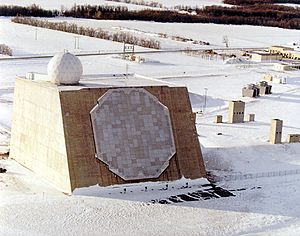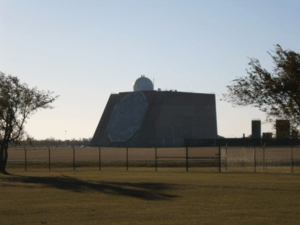AN/FPQ-16 PARCS facts for kids

EPARCS at Cavalier Space Force Station
|
|
| Country of origin | US |
|---|---|
| Introduced | 1975 |
| No. built | 1 |
| Type | phased array radar |
The AN/FPQ-16 Perimeter Acquisition Radar Attack Characterization System (PARCS or EPARCS) is a very powerful United States Space Force phased-array radar system. It is located in North Dakota, USA. This radar is the second most powerful of its kind used by the US Space Force. It helps warn about missiles and keeps an eye on objects in space.
PARCS was first built by General Electric. It was called the Perimeter Acquisition Radar (PAR). It was part of the US Army's Safeguard Program, which was an anti-ballistic missile system. PAR could detect incoming ICBMs (long-range missiles) up to 2,000 miles (3,200 km) away. It sent this information to other defense systems.
The PAR and other parts of the system were known as the Stanley R. Mickelsen Safeguard Complex. In 1972, the ABM Treaty was signed. This treaty limited the U.S. to having only one anti-missile base. Because of this, a second PAR radar being built in Montana was stopped. In 1975, the U.S. government decided to close the Mickelsen complex. It officially shut down in July 1976.
After the Mickelsen complex closed, the Air Force took over the PAR site in 1977. They used it for early warning. Later, it was also used to track satellites. Today, PARCS watches over half of all objects orbiting Earth. The radar was supposed to close in 1992, but instead, it was upgraded with new electronics and became EPARCS.
EPARCS is currently run by the 10th Space Warning Squadron. It also has U.S. and Canadian military members from NORAD working there.
Contents
What is PARCS?
How the Radar Works
The PAR radar was originally designed to find objects the size of a basketball (about 24 cm) from 3,300 km (2,050 miles) away. This means it could spot a warhead from a missile launched far away. It could even be made to see objects smaller than 9 cm (3.5 inches).
The main part of the radar is a huge wall with 6,888 small antennas. These antennas are called a "phased array." They are mounted on the building's slanted wall. Each antenna has two crossed parts that look like an arrowhead.
Inside the building, a special system controls these antennas. It can instantly point the radar's beam in any direction. This is done by changing the electrical signal to each antenna. This allows the radar to quickly scan large areas of the sky.
Other important parts of the radar include:
- A Beam Steering Computer that tells the antennas where to point.
- A Beam Power Supply that provides electricity to the radar.
- A Digital Data Group that helps with timing signals.
- A Radar Maintenance Console to check how the radar is working.
Other Important Systems
Besides the radar itself, the PARCS site has a very powerful electricity system. It uses five large diesel/natural gas engines to create 14 megawatts of power. This is enough to power a small town!
The building also has a satellite communications antenna on its roof. This antenna helps PARCS send and receive data. There is also an electrical substation and a cooling system.
The PAR Data Processor is like the radar's brain. It collects information about missiles and satellites. Then, it sends this data to places like NORAD (North American Aerospace Defense Command). This information is crucial for warning about attacks.
History of PARCS
Early Radar Ideas (MAR)
The design of PARCS comes from an older anti-missile program called Nike-X in the 1960s. Earlier systems could only track a few missiles at a time. To fix this, Bell Labs suggested using a new type of radar called the Zeus Multi-function Array Radar (ZMAR) in 1960. This was an early active electronically steered array radar.
The ZMAR, also called MAR, used many small antennas. Each antenna was connected to its own computer-controlled transmitter or receiver. This allowed one MAR radar to do many things at once. It could detect objects far away, track them, tell warheads apart from decoys, and even guide interceptor missiles.
MAR allowed a single site to control a large battle area. It could track hundreds of targets and assign them to different missile batteries. Some batteries were close to the MAR, while others were further away. The distant batteries used simpler radars called Missile Site Radars (MSR) to track outgoing missiles.
Developing PAR
The MAR system was very expensive. It could only be used to protect very important places like big cities. So, in 1965, scientists started thinking about a new, long-range early warning radar. This radar would mainly warn bases across the country. It didn't need to be super precise or sort out decoys. Its main job was to alert other radars. This allowed it to be built using simpler and cheaper technology.
As the cost of the Nike-X system grew, the Army looked for smaller, cheaper ways to protect against missiles. This led to the idea of using only MSRs and the new early-warning PARs. Bell Labs created the plans for PAR in 1966, and General Electric won the contract to build it. Under this new plan, PAR would not only detect targets but also help track them accurately. This meant it needed to be more precise than first thought.
In 1967, the decision was made to use UHF frequencies for PAR. This would allow the radar to be a reasonable size and still be precise. It also helped with a problem called nuclear blackout. Nuclear explosions can make parts of the sky "opaque" to radar. Higher frequencies are less affected by this. So, using UHF meant PAR could see clearly again more quickly after an explosion.
Sentinel and Safeguard Programs
New studies showed that a different type of anti-warhead attack could be very effective. This involved exploding a warhead outside the atmosphere. The explosion's X-rays could damage incoming warheads over a large area. This was much easier than trying to hit a warhead directly.
This led to a new missile called Spartan, which had a range of about 400 miles (640 km). These Spartans could protect the entire U.S. with fewer bases. This new system was called the Sentinel program. In Sentinel, PAR was not just for early detection. It also guided the Spartan missiles over long distances. This made PAR even more important.
In September 1967, General Electric was given the go-ahead to start building the PAR system.
However, the Sentinel program was later canceled due to costs and other issues. On March 14, 1969, President Richard Nixon announced a new program called Safeguard Program. This program would place a small number of Sprint missiles around the Air Force's Minuteman missile bases. The goal was to protect these missile bases from a surprise attack. This would ensure the Minuteman missiles could survive and act as a strong deterrent.
The first two Safeguard sites were chosen in Montana and North Dakota. Only these first sites needed a PAR radar. The North Dakota site was chosen as the main research and development site for PAR.
Building and Closing PAR
Construction on PAR-1 in North Dakota began in April 1970. Work continued until August 1972. At that time, the Strategic Arms Limitation Talks (SALT) agreements were signed. The ABM Treaty from SALT limited both countries to only one anti-ballistic missile site each. Because of this, work on PAR-2 in Montana stopped. The unfinished building is still there today.
Major construction on PAR-1 was finished on August 21, 1972. Testing began. The radar successfully tracked a satellite and a radio star in August 1973. The entire Mickelsen base became fully operational on October 1, 1975.
However, just one day later, the U.S. government voted to shut down the Mickelsen complex and end the Safeguard program. The missiles were removed, and the MSR radar was shut down in February 1976.
PAR Becomes CMEWS and PARCS
In September 1977, the Air Force took over the PAR radar. They started using it in October 1977. The Air Force called the base the Concrete Missile Early Warning System (CMEWS), named after a nearby town. When that town's post office closed in 1983, the base was renamed Cavalier Air Force Station. The radar itself became known as PARCS.
In 1983, PARCS was given the job of sending "tactical warning and attack assessment data" to Cheyenne Mountain Complex. This data helps warn about potential attacks.
Enhanced PARCS (EPARCS)
By 1989, the system was upgraded and became the Enhanced Perimeter Acquisition Radar Attack Characterization System (EPARCS). It was planned to close in September 1992, but instead, it was kept open and improved.
Since 2003, BAE Systems has helped maintain the radar and its other systems. Later, in 2017, Summit Technical Solutions became the main contractor for maintaining the radar system. The USAF has also been upgrading other similar radar systems to newer versions, and PARCS has also been part of modernization efforts.
See Also
- AN/FPS-115 PAVE PAWS
- AN/FPS-132 Upgraded Early Warning Radar
- Cobra Dane
- Thule Site J
Images for kids



